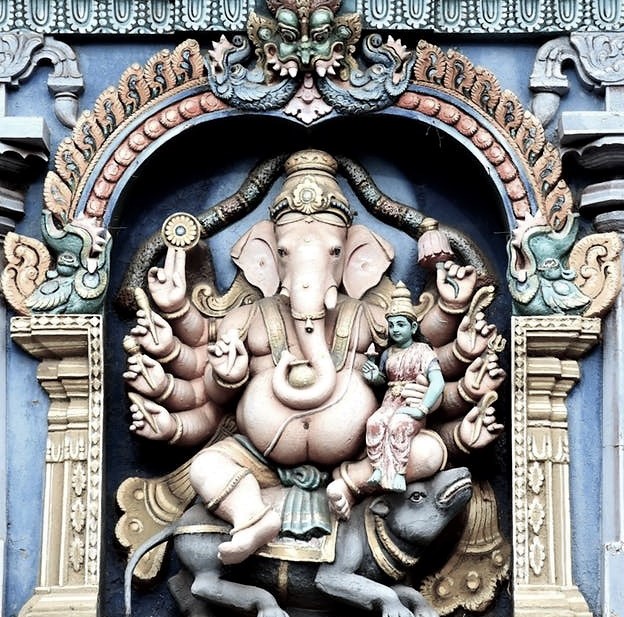- Special FeaturesFoundation Year1000 - 2000 years oldSthala TreeTheerthamRathamArchitectureOther SpecialityUnlike other temples, Kadampuzha is unique in that there are no idols for the Devi.
- Sthala Puran
Sree Kadampuzha Devi Temple is a Hindu Temple and pilgrimage center at Kadampuzha in Malappuram district, Kerela, India. The main deity of this temple is Goddess Parvati/Durga in the form of a huntress. There is no idol of Goddess in this temple, and she is worshipped in a pit.
The origin of the Kadampuzha Temple is associated with the Mahabharatha, the ancient Indian myth, considered to be the greatest story ever told. However, the temple as such was founded by Shree Shankaracharya, and the month he consecrated Kadampuzha Temple, the day of Karthika in the month of Virshchikam (November – December) is considered the most auspicious day and is celebrated as the festival day.
Shree Shankaracharya, during his Deshadanam, a pilgrimage to various parts of the country, came across this place while he was going to Chottanikkara Temple after his Darshan at Mookambika Temple. When he reached the place now known as Kadampuzha, he found that he could not walk cross and that his way was blocked by a Divine Presence. Even with the superior Sight that could “See” or “Understand” Divine presences, he could not fathom it. Perplexed, he meditated to understand why he failed to fathom the Divine Presence and within himself discovered that having attained the “Sarvaknanapeedhom”, his ego had somehow crept in to make him feel superior and that his ego was being shunned by the Divine Presence, making him unable to fathom it. The Divine Saint immediately set about cleaning his mind of any ego and made himself as humble and pure-minded as an innocent child. He approached the Divine Presence again with utmost devotion and supplication and immediately perceived what the presence was and wherein it was emanating from. He marveled at the Divine Presence of the Devi very strongly bonded with the Divine Presence of Lord Shiva and decided that the place should be treated with absolute reverence.
He discerned that the Divine power is emanating from the hole in the ground and took steps to consecrate the place as a temple and also constituted Lord Narasimha and Sudarshana Chakra in front of the Devi and also decided to place Dharmashasta and Nagakanyaka on either sides of the temple
- Architecture
The hole, divined to be the one created by the mighty arrow of Lord Shiva that summoned Ganga for quenching Parvathi’s thirst, was perceived as the Devine Power Source by Adi Shankara and hence there is no idol to represent the Presence here. That there are no idols here is also a unique aspect of Kadampuzha. To mark this place and for the common man’s reference, a Thidambu or Arch is kept on top. Only during the “Poo Moodal” rite, the Thidumbu is removed and the hole exposed.
Adi Shankara built the temple over this spot in the method prescribed by Thachu Sastra and on the stone right in front of this, the where the divine presence of Lord Shiva was perceived, he consecrated Narasimha Moorthy and the Sudarshana Chakra each facing South and north respectively. On the Southside of the temple, Naga Kanya was consecrated and Shastav on the North.
Then, around 1949, when Shree M.K Achutha Warier was the trustee, the sanctum sanctorum was rebuilt using laterite stones and the roof was built using jack wood and tiles. However, only the Northside was completed and the other three were laid bare. During this time the pilgrimage to the temple was rather bleak and the temple trustees found the upkeep rather tough.
Then in 1974, a Deva Prashnam was conducted and according to the divinations then made, Bharmashree Andaladi Divakaran Namboothiripad was made the Thantri (Chief Priest) and the compensatory poojas and other poojas for prosperity conducted by him brought about a huge change. Pilgrims started to folk Kadampuzha again and year after year this improved. Deva Prashnam was conducted again in 1984 and 1993 and whatever compensatory rituals suggested at those times were also religiously carried out. In the Deva Prashna of 1993, it was divined that the sanctum sanctorum was to be rebuilt using granite stones and the roof should be paved with brass and immediately the work was taken up and what we see is the result of that. The sanctum sanctorum was built using a complex calculation known as “Siddharthakam”.
- Alankar of Deity
- Prayers and BenefitsSpecial Vratas and Prayers
Devi is worshiped here in three forms. In the mornings she is worshiped as Vidya Durga (Saraswati) bestowing knowledge and excellence in career to all. In the afternoon she is worshiped as Vanadurga (Durga) in the Twaritha Devi form blessing the devotees with health, early marriage, and domestic harmony and in the evening as Aadi Durga (Mooladurga - Lakshmi) bestowing the devotees with wealth and overall prosperity
Offerings to DeityStotras and Mantras
- FestivalsThirukarthikaThe Karthika day in Vrischigam is celebrated as Pradishta day in Temple with Sudhi, Navakom, Panchagavyam, special kalasams, etc on the auspices of the Thanthri of the temple. The Poomoodal and all special poojas on this day are performed by Devaswom directly.Ramayana MonthSreemad Devi Bhagavatha Navaham is conducted in the month of Thulam every year.Bhagavatha SapthahaSreemad Bhagavatha Sapthaha is conducted in the month of Thulam / Virischigom every year.
- Sodasha Upcharas
- PrasadhasVella Nivadyam, Nai Payasam, Paal Payasam, Trimadhuram, Appam
- Social ActivitiesAnnadhanMarriageEar BoringHead ShaveDanaasEducation FacilitiesSocial DrivesOther Activities
- Arjita Seva
- Tags

